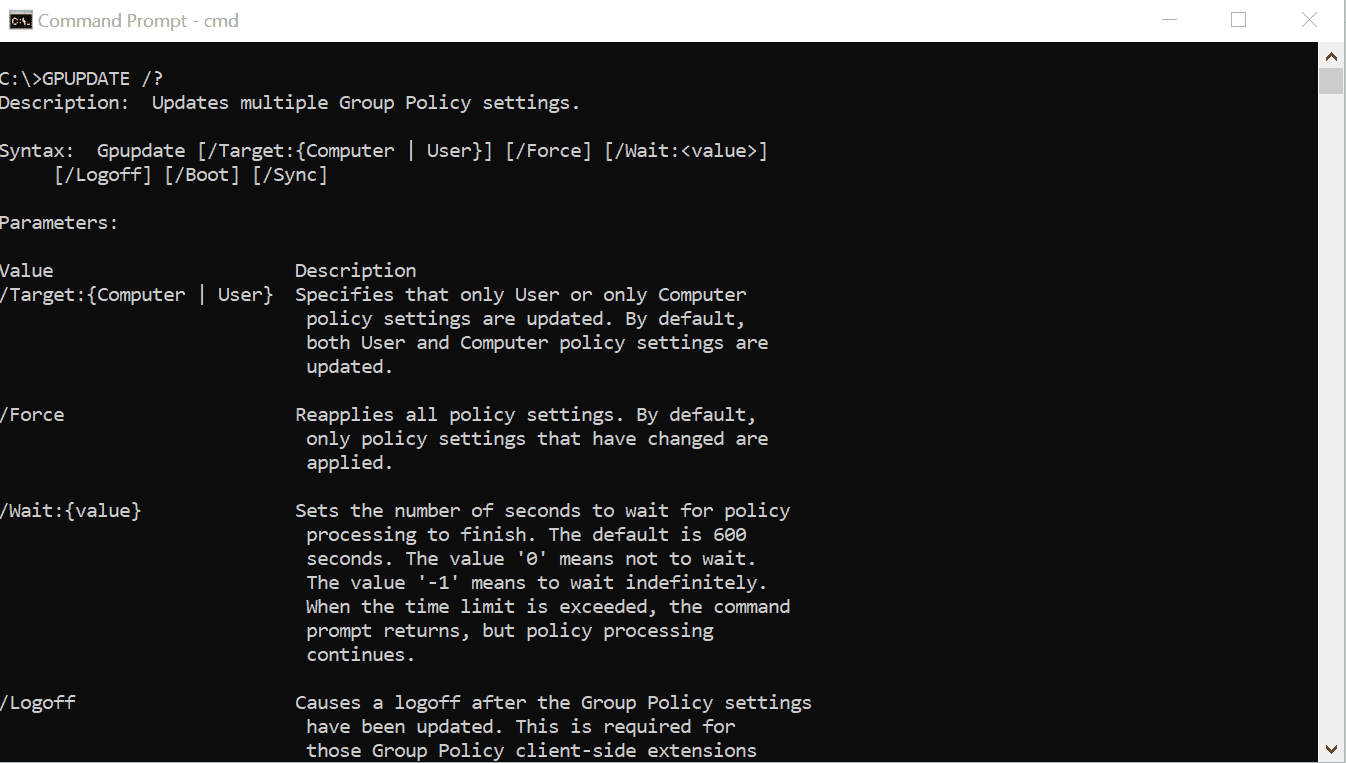How To Force Windows 10 Update

GPUPDATE Meaning (and What It Does)
GPUPDATE ways Grouping Policy Update Command. It is a Windows command line tool that is used to get a client reckoner to receive the latest Group Policy update settings.
In this guide, you will larn:
- GPUPDATE Syntax
- Pregnant of each Parameters in GPUPDATE Syntax
- Examples and Applications of GPUPDATE
GPUPDATE Syntax
If y'all are familiar with Windows commands y'all know that most windows commands have one or more than Syntax. A Syntax extends what a command can practise. The easiest way to get the syntax of a command is to add a forward slash with a question mark to the command then press Enter.
To become the GPUPDATE Syntax, enter the following in cmd so press the Enter key:
GPUPDATE /?
The outcome is shown in the prototype below.

You may also apply the command below:
GPUPDATE aid
From the effect, you can meet that the Syntax of GPUPDATE is:
Gpupdate [/Target:{Computer | User}] [/Force] [/Await:] [/Logoff] [/Kicking] [/Sync] In the next section, I will explain what each of the parameters in the Syntax do. Before then, it is of import to annotation from the syntax that with GPUPDATE, yous update Computer or User Policy or both. More on this later in the guide.
GPUPDATE Parameters Explained
The information that followed GPUPDATE in the Syntax higher up are called parameters. The table beneath explains what each parameter hateful.
| Parameter | Clarification | Notes |
| /Target:{Computer | User} | Specifies that only User or only Calculator policy should exist updated. By default, both both settings are updated. | By specifying /Taget:Computer, yous are request GPUPDATE to update Policies for Computers only. On the other hand, /Taget:User will just update User Policies. |
| /Force | By default, only GPO settings that have changed are applied. When you lot use the /Force parameter, all GPO policies are reapplied. | The /Force parameter is the most normally used parameters. |
| /Logoff | The GPUPDATE /Logoff parameter forces the computer to logoff after the GPO settings have been updated. | This is required for those GPO client-side extensions that practice non procedure policy on a background update cycle only do process policy when a user logs on. Examples include user-targeted Software Installation and Folder Redirection. /Logoff option has no result if there are no extensions chosen that crave a logoff. |
| /Wait:{value} | The /Await option of GPUPDATE sets the number of seconds to expect for policy processing to finish. | The default is 600 seconds. The value '0' means not to wait. The value '-1' means to wait indefinitely. When the time limit is exceeded, the command prompt returns, simply policy processing continues. |
| /Boot | This switch is like to /Logoff only instead of logoff, the computer volition restart later the Grouping Policy settings are applied. | |
| /Sync | Causes the adjacent foreground policy application to be done synchronously. Foreground policy applications occur at computer start up and user logon. Yous can specify this for the user, computer or both using the /Target parameter. | The /Forcefulness and /Look parameters will exist ignored if the /Sync parameter specified. |
GPUPDATE Examples and Applications
This section volition show some examples of GPUPDATE. The quickest mode to run GPUPDATE is without any parameter. Run into the control below:
GPUPDATE
The command without any parameter will update both computer and user policy. Meet the prototype below for the event.

To update just Estimator polices, enter the control below in a command prompt then press Enter.
GPUPDATE /Target:reckoner
Now, just the computer policy was updated. Run across the image beneath.

If you lot want to update just User policies, supplant figurer with user in the previous command.
GPUPDATE /Target:user
Meet the issue below:

Force GPUPDATE (How to Forcefulness GPUPDATE)
As I stated when I explained GPUPDATE parameters, running the control with the /Force parameter reapplies all GPO settings. If you wish to reapply all polices, execute the command beneath:
GPUPDATE /Forcefulness

Equally you can see from the epitome above, the command with the /Force switch reapplies both Computer and User policies.
If you wish to reapply but the Calculator or User policies, the /Force switch may be used with the /Target switch as shown below:
GPUPDATE /Force /Target:computer
The result of the command is shown beneath:

Decision
I promise this guide has improved your knowledge of GPUPDATE and how to use it. I also promise you found this Itechguide helpful.
If you accept any questions or comments, use the "Leave a Reply" form at the stop of the guide.
You could also share your experience so other readers can benefit from it.
Other Helpful Guides
- Powershell NoTypeInformation: Applications and Examples
- (Opens in a new browser tab)18 Powershell Commands Every Windows Admin Should Know
Additional Resources and References
- How to Refresh Windows Computer Policies
- Refresh Grouping Policy
- Was this post helpful?
- Yeah (iii)No (0)
Source: https://www.itechguides.com/gpupdate-group-policy-update-command-syntax-parameters-and-examples/
Posted by: rogersbethen.blogspot.com


0 Response to "How To Force Windows 10 Update"
Post a Comment